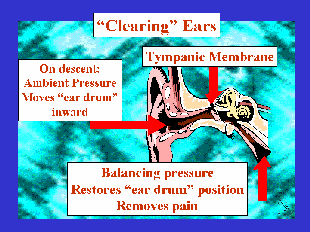
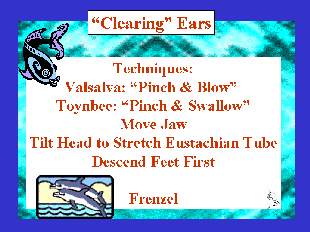
by
Larry "Harris" Taylor, Ph.D.
This
material is copyrighted and all rights retained by the author. This article is
made available as a service to the diving community by the author and may be
distributed for any non-commercial or Not-For-Profit use.
All
rights reserved.
Much of this particular article is from my Friday Night Review (105 images, 2.2 megs) that I use as a course refresher on the night before first open water training.
Go To: Home About "Harris" Articles Slides War Stories Editorials Links Fini
Jump To: Pre-Dive Descent Ascent Post-Dive
The single most common problem in pool training and during the first weekend of diving is ear damage as a result of inability of the diver to equalize pressure between the middle and outer ear. I have seen reports claiming as many as in 80% of divers show observable tympanic membrane damage during their first few dives. Fortunately, most of this damage is slight and easily repairs with time. The process of "clearing ears" or equalizing pressure between the middle and outer ear is typically easily mastered. But, like all diving skills, a bit of understanding of the physical nature of the problem, coupled with practice of the physical skills involved rapidly leads to pain-free diving.
Pre-Dive
As part of all pre-dive evaluations, a diver should access physical, emotional and mental fitness. Any respiratory inflammation should be disqualifying because of increased risk to barotrauma of lungs and ears. My personal philosophy is that if you need decongestant drugs, then you should not be sport diving. The reason for this is that all drugs have a time-course of action. If the drug effectiveness decreases near the end of the dive, then there is an increased risk of reverse block. Also, when the drug wears off, there is typically a "rebound" effect and tissue may become more swollen than the pre-drug condition.
A large segment of the adult population has a deviated septum. While not normally an issue, this slight imperfection can create problems in effectively equalizing pressure in the middle ears. Those with this problem may frequently demonstrate difficulty in equalizing pressure between the middle ear and ambient. Most often, those with this slight anatomical problem will show a distinct difference in ease of "clearing" ... one ear will continually pose a problem. Those who repeatedly have problems equalizing ear pressure during training should be examined by a hyperbaric knowledgeable ENT specialist. Generally, if the equalization difficulty is anatomical (deviated septum), it can be easily fixed with a simple single day out-patient procedure.
Immediately prior to diving, while still on the surface, try a soft Frenzel (see below). You should hear a soft click in the ears. This is your assurance that the Eustachian tubes are open and ready to dive. The concept is to clear early and often so as not to allow pressure differences between middle and outer ear to become large enough to cause pain.
There should be nothing to restrict access of the outer ear to the water. So, hoods should be snug, but not so tight as to keep the ears totally dry. Mask straps should not be directly over the ear canal opening.
Lastly, ensure that you are wearing the proper amount of weight. Too many divers enter the water over-weighted. Diving over-weighted may lead to rapid changes in depth and this could lead to increased risk of ear damage, especially if there is some difficulty clearing.
Descent
As we descend in the water column, the weight of the water (and atmosphere) above us pushes against all body cavities (air spaces). These spaces will begin to collapse under this weight/pressure. This collapse is called a "squeeze." As the water pressure pushes against the ear drum (tympanic membrane), this thin flap of skin stretches inwards, leading to discomfort and pain. If there is too much stretch, the membrane ruptures. It is possible to rupture the tympanic membrane of an adult in as shallow as eight feet of water. Little kids can rupture with less depth. I personally know of cases where a a shallow pool dive lead to deafness in an an eight year old girl. The mechanism to prevent this discomfort is called "clearing" or "equalization." There are a variety of techniques employed, but they all share a common characteristic in that the goal is to send breathing gas into the middle ear via the Eustachian tube. This movement of gas into the middle ear cavity brings the middle ear pressure to the same level as the ambient water pressure pushing against the tympanic membrane. It essentially restores the tympanic membrane to its proper equilibrium position and relieves any discomfort.


There are a variety of techniques one can use. The most commonly taught, the Valsalva (pinch nostrils and GENTLY attempt to force air out the closed nostrils), has a number of potential problems. The "pinch and blow" technique raises thoracic pressure, which is transmitted via the cerebral-spinal fluid to the inner ear. A sudden, dramatic increase in pressure can damage inner ear structure. In a worst-case scenario, a membrane on the inner ear called the round window may rupture. Typically, once ruptured, without rapid surgical repair, there is a high probability of permanent deafness. In addition, many people in applying this technique will, through involuntary muscular action, squeeze the muscles around the Eustachian tube and make the clearing process more difficult. This is exacerbated if clearing is difficult 'cause divers will often use more and more force in an effort to clear. This is a particular concern with younger divers because the Eustachian tube has a less vertical orientation and is easily collapsed, especially when pressure in the middle ear is less than ambient. Part of the process of adolescence is an enfolding of the Eustachian tube lining to form ridges which resist collapse or closing of the Eustachian tube with pressure changes.. Finally, if a PFO is present (~ 25 % of the adult population, perhaps more in adolescents and children), a forceful Valsalva on repeat dives can send bubbles (if present) circulating in the system through the PFO into the arterial side of circulation. Thus, a forceful Valsalva makes an air embolism on descent theoretically possible, but most likely a very low probability event. There are medical reports linking cerebral decompression sickness with forceful Valsalva maneuvers. Since I SUSPECT a too forceful Valsalva is responsible for much of the barotrauma seen in the ears of novice divers, I prefer to use other, less traumatic methods.
Another common technique, the Toynbee, involves pinching the nostrils and swallowing. This problem with this technique is that swallowed air at depth, on ascent, will expand and cause gastric distress. It is best while submerged to avoid swallowing air. Stomach discomfort in novice divers (presumably from swallowing air) is quite common. In a worst-case scenario, the expanding air can rupture the stomach.
I believe the least stressful, most effective way to clear the ears is the Frenzel procedure. This technique was utilized by German Stuka bomber pilots during WWII. At the time, the Stuka bomber attacks were the most precise form of bombing. The pilots would put their plane into a steep dive aimed directly towards the target. Just before crashing into the ground, the aircraft would release the bomb and pull out of the dive. The bomb would follow the launch trajectory and fall into the target. Because this was before the time of computer-aided hydraulics in aircraft, it was necessary for the pilot to use both hands on the control stick to physically pull out of the dive. Since the plane was undergoing rapid pressure changes, and both hands were required to be on the control stick, it was imperative that a hands-free, rapid, effective and safe method of clearing ears was used. The technique they used was developed in 1938 by a German physician named Herman Frenzel.The Frenzel technique is done by placing the tongue on the roof of the mouth, as far forward as possible. While the tongue is held in place, the back of the tongue is gently moved upward. (Imagine driving the tongue through the back of your head. Obviously, you cannot do this, but striving to do so will move the tongue such that a gentle puff of air moves up the Eustachian tube to increase the pressure in the middle ear). Often a "click" sound is heard internally as the tongue is moved. This action does NOT constrict the Eustachian tubes, does NOT over-pressurize the middle or inner ear, and leaves the hands free. It is the safest, most effective way for divers to equalize the pressure in he middle ear. It does, however, take a bit pf practice to master. But, once mastered, it provides safe, effective and hands-free clearing. It is, in my opinion, the method of choice for divers to solve equalization problems.
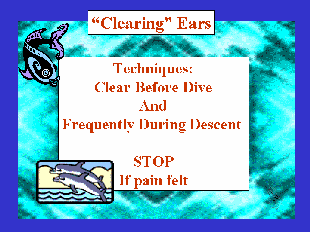
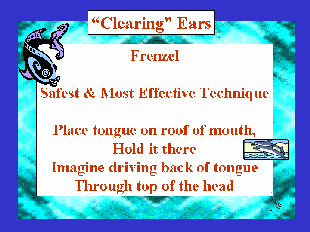
Other behaviors that can assist in equalizing pressure are beginning the clearing procedure prior to dive descent and to "clear" continually during descent (If you feel pain, you have already descended too far ... continual repeating of the clearing technique during descent prevents a pressure build-up in the outer ear), moving the jaw back-and-forth, tilting the head away from the affected ear (to stretch the Eustachian tube), and a feet first descent. A feet first descent allows the natural pressure gradient (Pressure is greater on lower portion of the body than on the head in a vertical-feet first descent) to assist clearing, facilitates buddy contact during the critical first few moments of descent and helps maintain orientation. A head first descent forces the diver to clear against the pressure gradient. The head first dive also places the diver's inner ear's semi-circular canals (that determines three dimensional body positioning) at the worst possible angle to determine body orientation in the environment.
If you feel pain at any time, stop! Do not descend any more until pain is relieved. Often, a slight ascent, followed by an attempt to clear the ears will relieve the discomfort.
IT IS YOUR RESPONSIBILITY TO LET THE NEAREST PERSON KNOW YOU HAVE A DIFFICULTY! 'cause no one but you knows of an internal pain! If you positively can not clear, then it is best to abort the dive and dive another day. It is better to abort (to dive again on another day) rather than force a situation that may cause permanent injury.
The guiding principle in any equalization technique is to emulate driving in Maryland ... Drive ("clear") GENTLY!
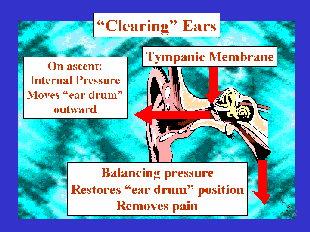

On ascent, the situation in the middle ear is reversed: pressure in the middle ear is now greater than ambient. Typically, the expanding gas vents via the Eustachian tube without a problem. However, there may be times when localized swelling of the tissue surrounding the Eustachian tube (repeated stretch and collapse during a long dive), especially on repeat dives, hinders the escape of venting gas. If drugs were used to assist in keeping the Eustachian tubes open, it is possible, particularly with repeated doses, that the drug effectiveness will decrease with time and have little effect on ascent. In the worst-case scenario, the expanding air has difficulty moving through the restricted channel. This is called a "reverse block."
If ear pain is felt on ascent, immediately stop the ascent and let your buddy know there is a problem. Often a slight descent will relieve the discomfort. A common error is to repeat the same technique used for descent ("pinch and blow"), but this makes things worse 'cause it drives air into an already over-pressurized middle ear cavity. So, in the presence of discomfort on ascent, pinching the nose and GENTLY sucking will assist in draining excess air from the middle ear.
Sometimes. on ascent, because of anatomical differences, one side of the head might equalize middle ear and ambient pressure more easily than the other side. If this occurs, then the pressures in the middle ears will be different. The brain interprets this situation as a spinning motion. This malady is called alternobaric vertigo (vertigo caused by pressure differences). If this occurs. descend a bit, grab or focus on something non-moving. If a descent does not lessen the problem, try a gentle "pinch and suck" in an attempt to remove the excess pressure. Repeated vertigo episodes on ascent suggest a visit to an ENT specialist to see of there is an anatomical explanation for the reoccurrences.
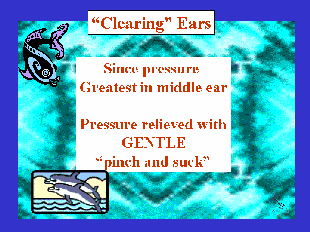
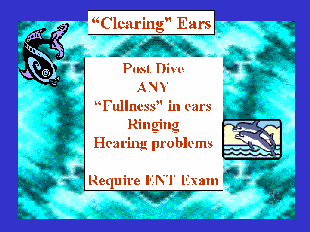
After the dive, it is important to do a self-assessment of your physical, mental and emotional state .Any feeling of ear discomfort (pain, a "fullness," ringing, deafness, etc.) should be evaluated by a diving knowledgeable physician before resuming diving. A feeling of "fullness" may be acutely removed with a very GENTLE pinch and suck (relieve any excess middle ear pressure). However, the use of this technique to temporarily relieve discomfort suggests it is appropriate to visit an ENT for a quick check. My basic philosophy is to always seek medical confirmation of dive status: A slight delay in diving to receive an exam is far more desirable than diving with a dismissed problem and doing permanent damage. Again, I say, the decision NOT to dive is always correct!
Lastly, there is a risk of developing an outer ear infection. This so-called swimmer's ear or external otitis can be most painful. Fortunately, this is easily prevented. After every day of diving, turn you head on its side and fill the ear canal with white vinegar. Hold this position for a few seconds and then tilt the head to drain the ear. The low pH (acidic) of the vinegar kills bacteria and fungus that would otherwise grow in the moist, dark spaces on the outer ear. Over the years there has been discussion about using an alcohol/vinegar mix. But, Charles Farmer, a noted ENT specialist at Duke University, pointed out (DAN course for Physician's, mid 1980's) that alcohol can dissolve (and thus remove) the wax that is a protective layer of the outer ear canal. So, its best to simply use white vinegar with no alcohol.
Bottom Line: It is absolutely imperative that diver's enter the water with an ability to equalize pressure. Failure to equalize pressure in the middle ear can lead to pain and in the worst case scenario, permanent loss of hearing. But, the Frenzel pressure equalizing technique, with practice, can provide the diver with hands-free, safe, effective and pain-free diving.
Jump To: Pre-Dive Descent Ascent Post-Dive
Go To: Home About "Harris" Articles Slides War Stories Editorials Links Fini
About
The Author:
Larry "Harris" Taylor, Ph.D. is a biochemist and Diving Safety Coordinator at the University of Michigan. He has authored more than 200 scuba related articles. His personal dive library (See Alert Diver, Mar/Apr, 1997, p. 54) is considered one of the best recreational sources of information In North America.
All rights reserved
Use of these articles for personal or organizational profit is specifically denied.
These articles may be used for not-for-profit diving education